Fabrication and Characterization of Photovoltaic Microgenerators Using the Complementary Metal Oxide Semiconductor Process
Abstract
:1. Introduction
2. Design of the Photovoltaic Microgenerator
3. Fabrication of the Photovoltaic Microgenerator
4. Results
5. Conclusions
Author Contributions
Funding
Data Availability Statement
Conflicts of Interest
References
- Gu, Q.; Li, S.; Gong, W.; Ning, B.; Hu, C.; Liao, Z. L-SHADE with parameter decomposition for photovoltaic modules parameter identification under different temperature and irradiance. Appl. Soft Comput. 2023, 143, 110386. [Google Scholar] [CrossRef]
- Liao, Q.; Li, S.; Xi, F.; Tong, Z.; Chen, X.; Wan, X.; Ma, W.; Deng, R. High-performance silicon carbon anodes based on value-added recycling strategy of end-of-life photovoltaic modules. Energy 2023, 281, 128345. [Google Scholar] [CrossRef]
- Zhang, J.; Zhong, A.; Huang, G.; Yang, M.; Li, D.; Teng, M.; Han, D. Enhanced efficiency with CDCA co-adsorption for dye-sensitized solar cells based on metallosalophen complexes. Sol. Energy 2020, 209, 316–324. [Google Scholar] [CrossRef]
- Rehman, M.A.; Park, S.; Khan, M.F.; Bhopal, M.F.; Nazir, G.; Kim, M.; Farooq, A.; Ha, J.; Rehman, S.; Jun, S.C.; et al. Development of directly grown-graphene–silicon Schottky barrier solar cell using co-doping technique. Int. J. Energy Res. 2022, 46, 11510–11522. [Google Scholar] [CrossRef]
- Dheyab, A.B.; Wali, L.A.; Alwan, A.M.; Naseef, I.A. Perfect incorporation of AuNPs on the p-n+ porous silicon for highly-efficient solar cells. Optik 2019, 198, 163317. [Google Scholar] [CrossRef]
- Wali, L.A.; Dheyab, A.B.; Alwan, A.M. Study the influence of shell thickness in bimetallic Ag core&Au shell configurations integrated in bare Si PN junction solar cells. Mater. Sci. Eng. B 2023, 288, 116210. [Google Scholar]
- Qiu, L.; Deng, J.; Lu, X.; Yang, Z.; Peng, H. Integrating perovskite solar cells into a flexible fiber. Angew. Chem. Int. Ed. 2014, 53, 10425–10428. [Google Scholar] [CrossRef] [PubMed]
- Hyun, J.H.; Ha, D.S.; Han, D.D.; Kyung, C.M. A solar energy harvesting system for a portable compact LED lamp. In Proceedings of the IECON 2015−41st Annual Conference of the IEEE Industrial Electronics Society, Yokohama, Japan, 9−12 November 2015; pp. 001616–001621. [Google Scholar]
- Sakai, J.; Fujinaka, E.; Nishimori, T.; Lto, N.; Adachi, J.; Nagano, S.; Murakami, K. High efficiency organic solar cells by screen printing method. In Proceedings of the Conference Record of the Thirty-First IEEE Photovoltaic Specialists Conference, Lake Buena Vista, FL, USA, 3–7 January 2005; pp. 125–128. [Google Scholar]
- Arima, Y.; Ehara, M. On-chip solar battery structure for CMOS LSI. IEICE Electron. Express 2006, 3, 287–291. [Google Scholar] [CrossRef]
- Marwick, M.A.; Andreou, A.G. Photo-battery fabricated in silicon on sapphire CMOS. Electron. Lett. 2008, 44, 766–767. [Google Scholar] [CrossRef]
- Law, M.K.; Bermak, A. High-voltage generation with stacked photodiodes in standard CMOS process. IEEE Electron Device Lett. 2010, 31, 1425–1427. [Google Scholar] [CrossRef]
- Horiguchi, F. Integration of series-connected on-chip solar battery in a triple-well CMOS LSI. IEEE Trans. Electron Device 2012, 59, 1580–1584. [Google Scholar] [CrossRef]
- Hung, Y.J.; Chuang, T.Y.; Chun, C.L.; Cai, M.S.; Su, H.W.; Lee, S.L. CMOS-enabled interdigitated back-contact solar cells for biomedical applications. IEEE Trans. Electron Device 2014, 61, 4019–4024. [Google Scholar] [CrossRef]
- Hung, Y.J.; Cai, M.S.; Su, H.W. High-voltage generation in CMOS photovoltaic devices by localized substrate removal. IEEE Electron Device Lett. 2016, 37, 754–757. [Google Scholar] [CrossRef]
- Hung, Y.J.; Cheng, Y.C.; Cai, M.S.; Lu, C.H.; Su, H.W. High-voltage 12.5-V backside-Illuminated CMOS photovoltaic mini-modules. IEEE J. Electron. Device Soc. 2018, 6, 135–138. [Google Scholar] [CrossRef]
- Yan, J.; Liao, X.; Ji, S.; Zhang, S. MEMS-based thermoelectric–photoelectric integrated power generator. J. Microelectromech. Syst. 2019, 28, 1–3. [Google Scholar] [CrossRef]
- Sichao, J.; Liao, X. Researches on MEMS thermoelectric-photoelectric integrated energy harvester with metal heat sink. Microelectron. J. 2020, 96, 104702. [Google Scholar]
- Krayden, A.; Shlenkevitch, D.; Blank, T.; Stolyarova, S.; Nemirovsky, Y. Selective sensing of mixtures of gases with CMOS-SOI-MEMS sensor dubbed GMOS. Micromachines 2023, 14, 390. [Google Scholar] [CrossRef]
- Shen, W.C.; Shih, P.J.; Tsai, Y.C.; Hsu, C.C.; Dai, C.L. Low-concentration ammonia gas sensors manufactured using the CMOS-MEMS technique. Micromachines 2020, 11, 92. [Google Scholar] [CrossRef]
- Yang, M.Z.; Dai, C.L.; Wu, C.C. A zinc oxide nanorod ammonia microsensor integrated with a readout circuit on-a-chip. Sensors 2011, 11, 11112–11121. [Google Scholar] [CrossRef]
- Guo, Y.; Ma, H.; Lan, J.; Liao, Y.; Ji, X. Impact of various thermistors on the properties of resistive microbolometers fabricated by CMOS process. Micromachines 2022, 13, 1869. [Google Scholar] [CrossRef]
- Dai, C.L.; Kao, P.H.; Tai, Y.W.; Wu, C.C. Micro FET pressure sensor manufactured using CMOS-MEMS technique. Microelectron. J. 2008, 39, 744–749. [Google Scholar] [CrossRef]
- Teo, A.J.T.; Li, K.H.H. Realization of three-dimensionally MEMS stacked comb structures for microactuators using low-temperature multi-wafer bonding with self-alignment techniques in CMOS-compatible processes. Micromachines 2021, 12, 1481. [Google Scholar] [CrossRef] [PubMed]
- Dai, C.L.; Peng, H.J.; Liu, M.C.; Wu, C.C.; Hsu, H.M.; Yang, L.J. A micromachined microwave switch fabricated by the complementary metal-oxide semiconductor post-process of etching silicon dioxide. Japan. J. Appl. Phys. 2005, 44, 6804–6809. [Google Scholar] [CrossRef]
- Perelló-Roig, R.; Verd, J.; Bota, S.; Segura, J. A Tunable-gain transimpedance amplifier for CMOS-MEMS resonators characterization. Micromachines 2021, 12, 82. [Google Scholar] [CrossRef] [PubMed]
- Dai, C.L.; Chen, Y.L. Modeling and manufacturing of micromechanical RF switch with inductors. Sensors 2007, 7, 2660–2670. [Google Scholar] [CrossRef] [PubMed]
- Zaman, A.; Alsolami, A.; Wei, M.; Rivera, I.; Baghelani, M.; Wang, J. Lateral extensional mode piezoelectric ZnO-on-Nickel RF MEMS resonators for back-end-of-line integration. Micromachines 2023, 14, 1089. [Google Scholar] [CrossRef] [PubMed]
- Cheng, Y.C.; Dai, C.L.; Lee, C.Y.; Chen, P.H.; Chang, P.Z. A circular micromirror array fabricated by a maskless post-CMOS process. Microsyst. Technol. 2005, 11, 444–451. [Google Scholar] [CrossRef]
- Peng, S.W.; Shih, P.J.; Dai, C.L. Manufacturing and characterization of a thermoelectric energy harvester using the CMOS-MEMS technology. Micromachines 2015, 6, 1560–1568. [Google Scholar] [CrossRef]
- Lin, C.H.; Song, C.H.; Wen, K.A. Multi-function microelectromechanical systems implementation with an ASIC compatible CMOS 0.18 μm process. Micromachines 2021, 12, 314. [Google Scholar] [CrossRef]
- Hu, Y.C.; Dai, C.L.; Hsu, C.C. Titanium dioxide nanoparticle humidity microsensors integrated with circuitry on chip. Sensors 2014, 14, 4177–4188. [Google Scholar] [CrossRef]
- Lee, A.H.; Lee, J.; Laiwalla, F.; Leung, V.; Huang, J.; Nurmikko, A.; Song, Y.K. A scalable and low stress post-CMOS processing technique for implantable microsensors. Micromachines 2020, 11, 925. [Google Scholar] [CrossRef]
- Yang, M.Z.; Dai, C.L.; Hong, J.Y. Manufacture and characterization of high Q-factor inductors based on CMOS-MEMS techniques. Sensors 2011, 11, 9798–9806. [Google Scholar] [CrossRef] [PubMed]
- Chen, Z.; Law, M.K.; Mak, P.I.; Martins, R.P. A single-chip solar energy harvesting IC using integrated photodiodes for biomedical implant applications. IEEE Trans. Biomed. Circuits Syst. 2017, 11, 44–53. [Google Scholar] [CrossRef] [PubMed]
- Ballo, A.; Grasso, A.D.; Palumbo, G. A bulk current regulation technique for dual-branch cross-coupled charge pumps. IEEE Trans. Circuits Syst. II Express Briefs 2022, 69, 4128–4132. [Google Scholar] [CrossRef]
- Kuo, P.H.; Wong, O.Y.; Tzeng, C.K.; Wu, P.W.; Chiao, C.C.; Chen, P.H.; Chen, P.C.; Tsai, Y.C.; Chu, F.L.; Ohta, J.; et al. Improved charge pump design and ex vivo experimental validation of CMOS 256-pixel photovoltaic-powered subretinal prosthetic chip. IEEE Trans. Biomed. Eng. 2020, 67, 1490–1504. [Google Scholar] [CrossRef] [PubMed]
- Ballo, A.; Grasso, A.D.; Palumbo, G. Fully on-chip charge pump-based boost converter in 65-nm CMOS for single solar cell powered IC. In Proceedings of the 2023 IEEE International Symposium on Integrated Circuits and Systems, Monterey, CA, USA, 21−25 May 2023; pp. 1–5. [Google Scholar]
- Chiang, T.Y.; Dai, C.L.; Lian, D.M. Influence of growth temperature on the optical and structural properties of ultrathin ZnO films. J. Alloys Compd. 2011, 509, 5613–5626. [Google Scholar] [CrossRef]
- Sun, M.; Liao, X. Modeling of the photoelectric–thermoelectric integrated micropower generator. IEEE Trans. Electron. Device 2021, 68, 4509–4515. [Google Scholar] [CrossRef]
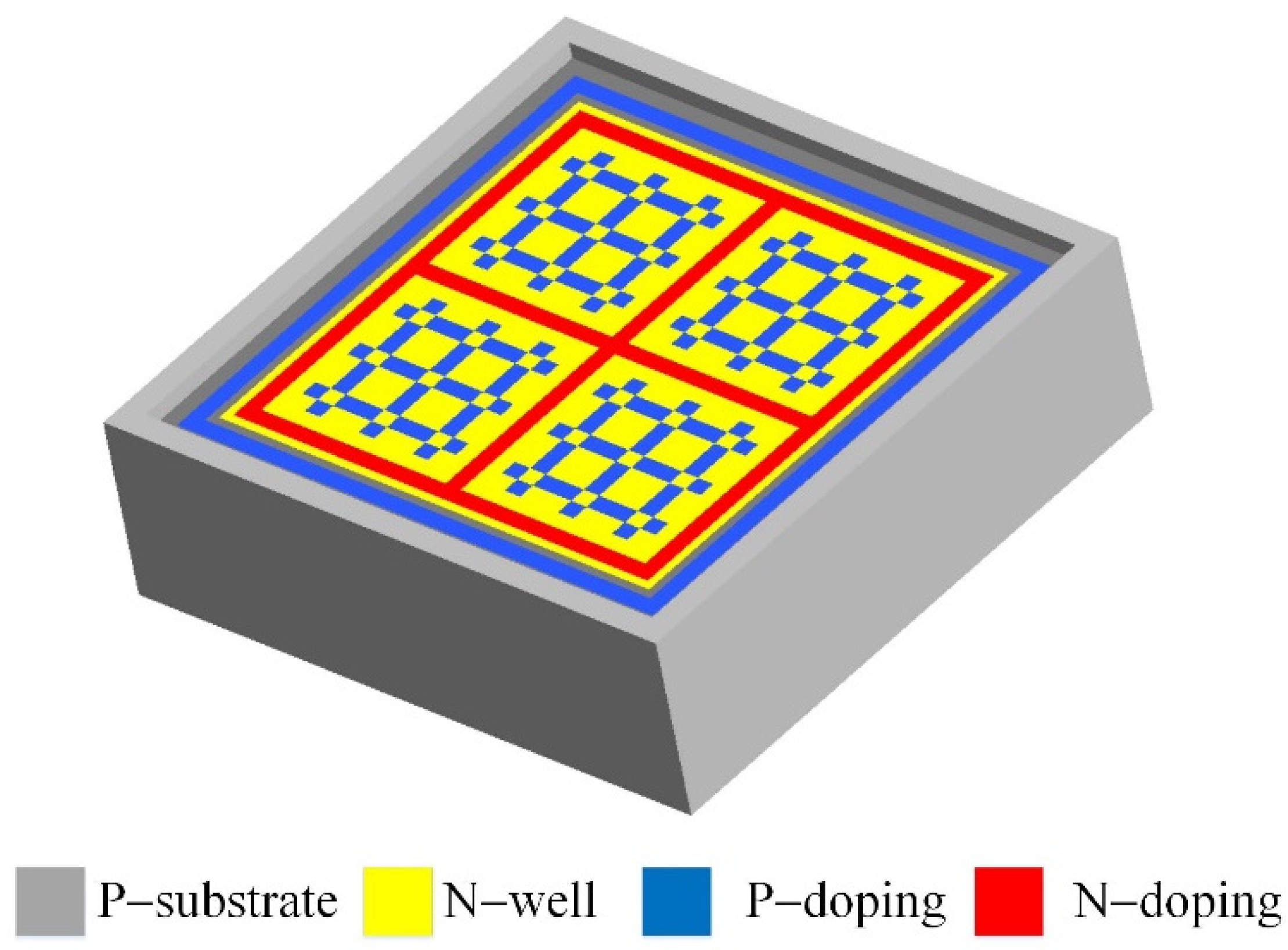
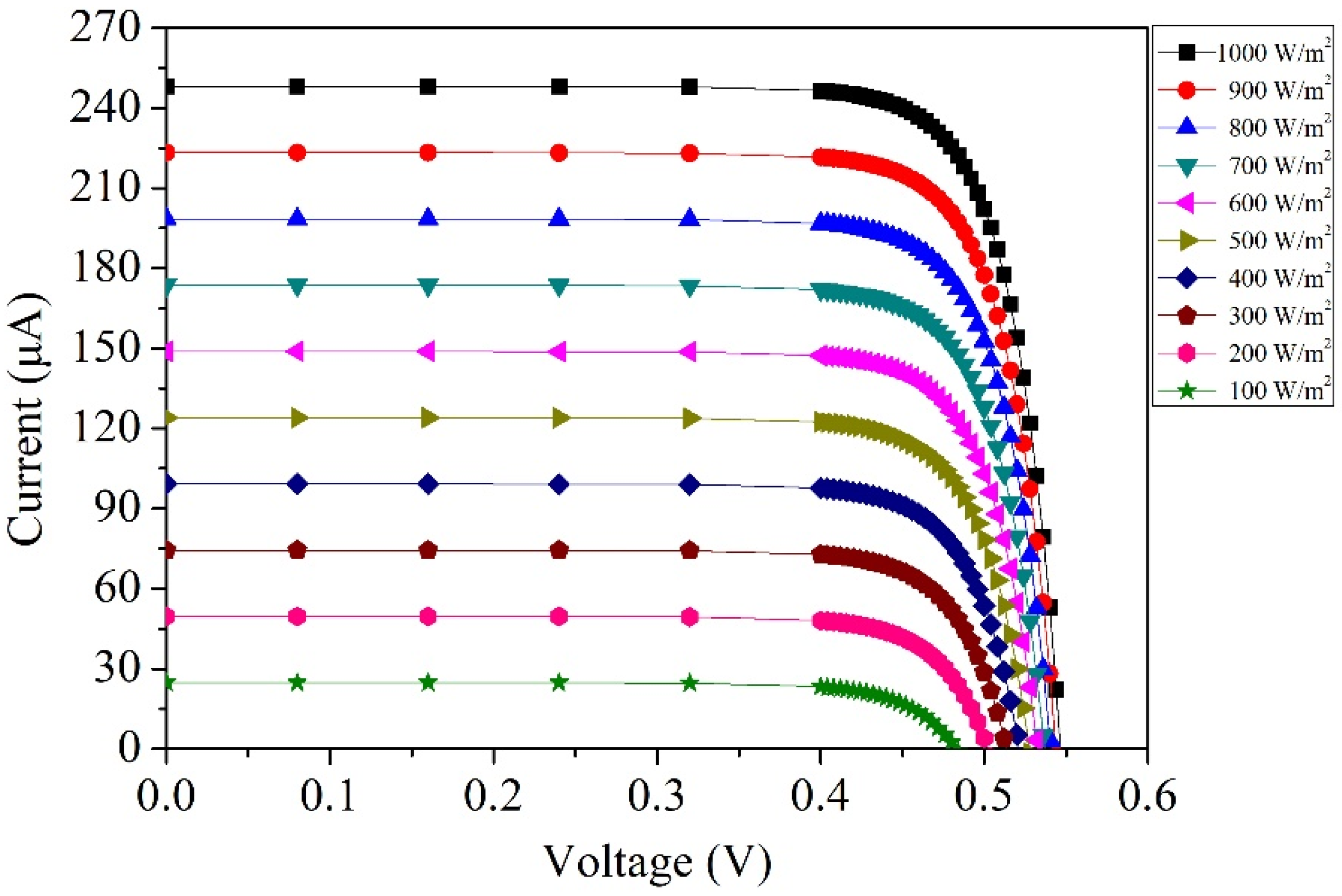
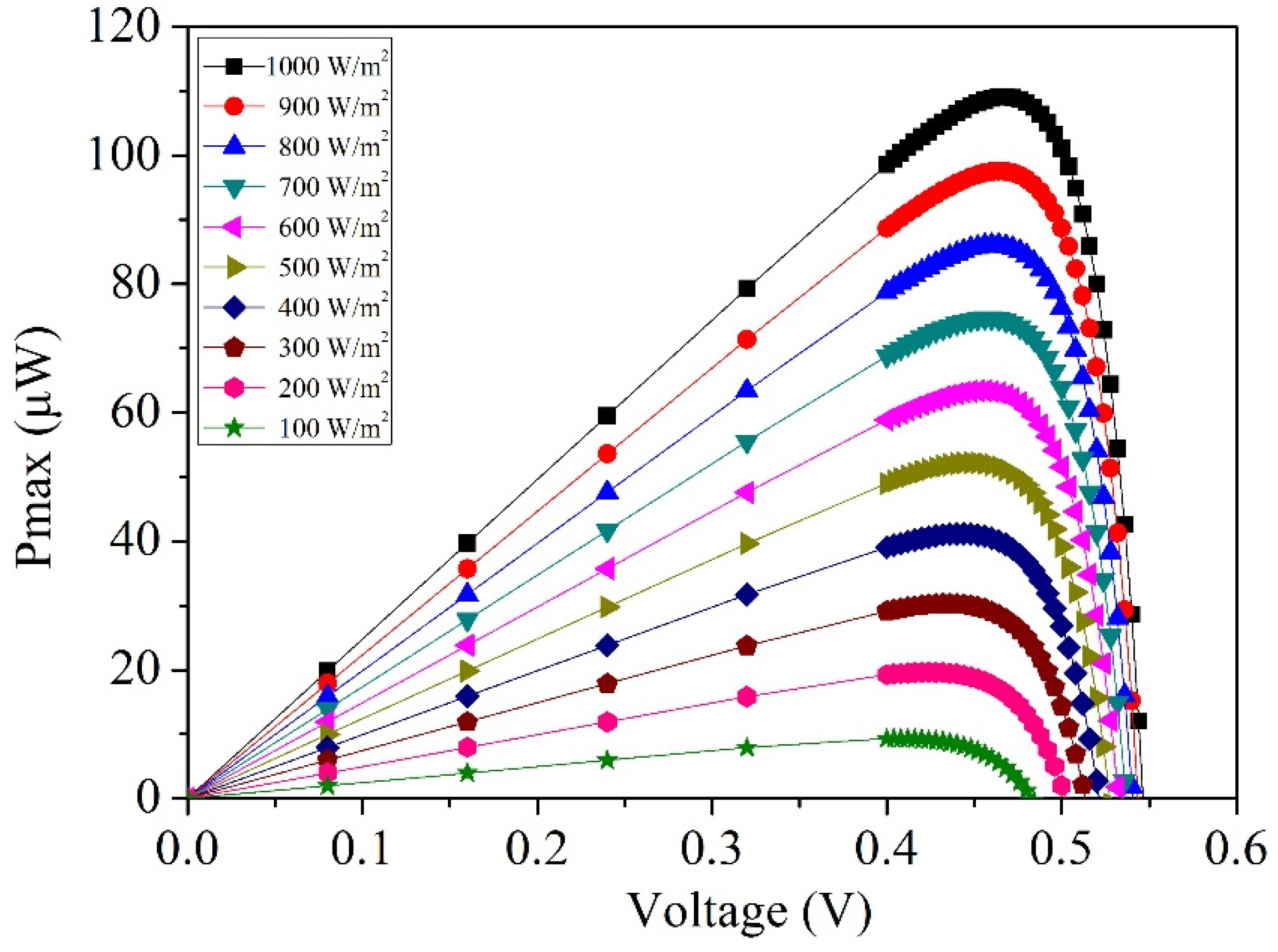
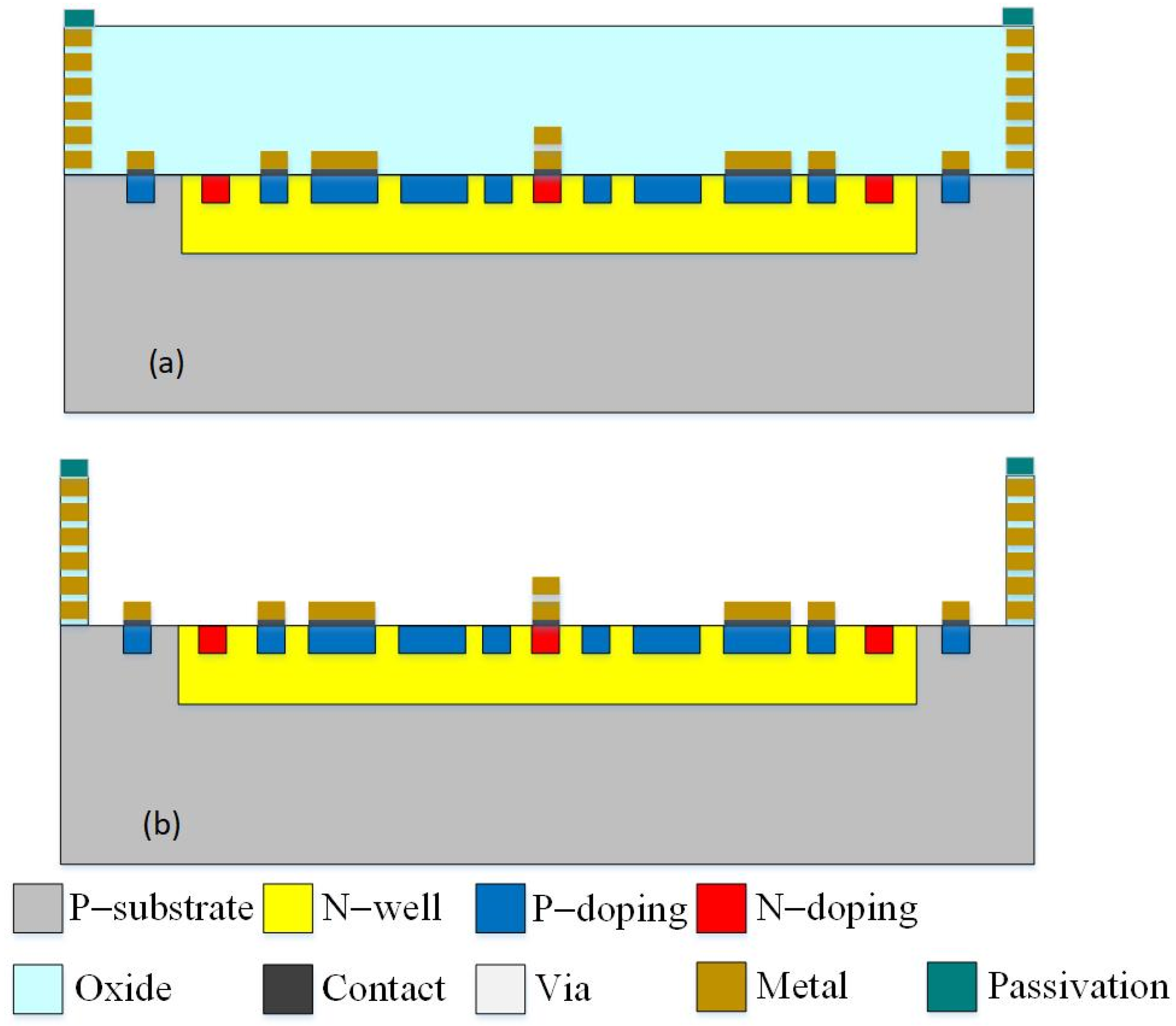

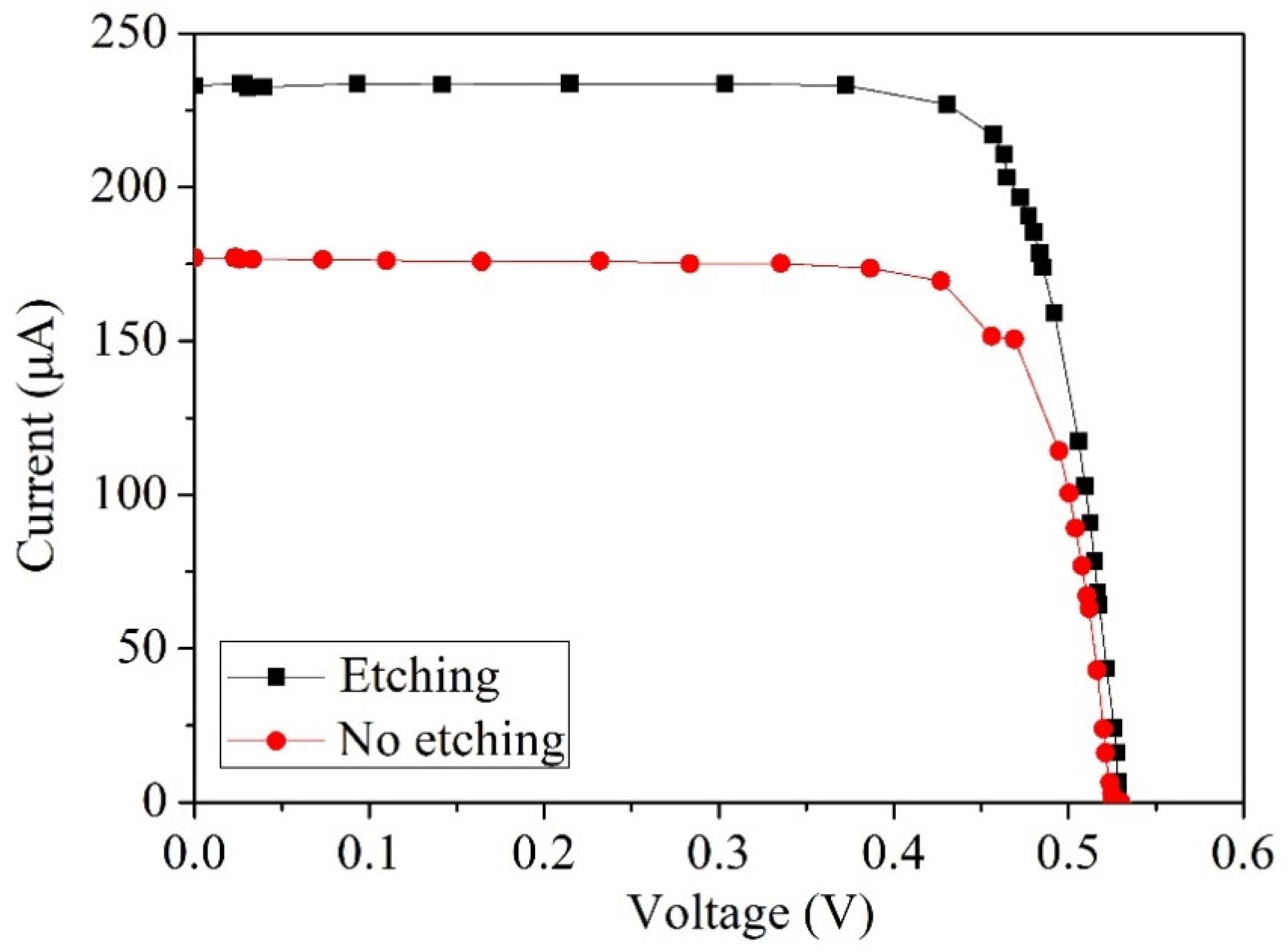
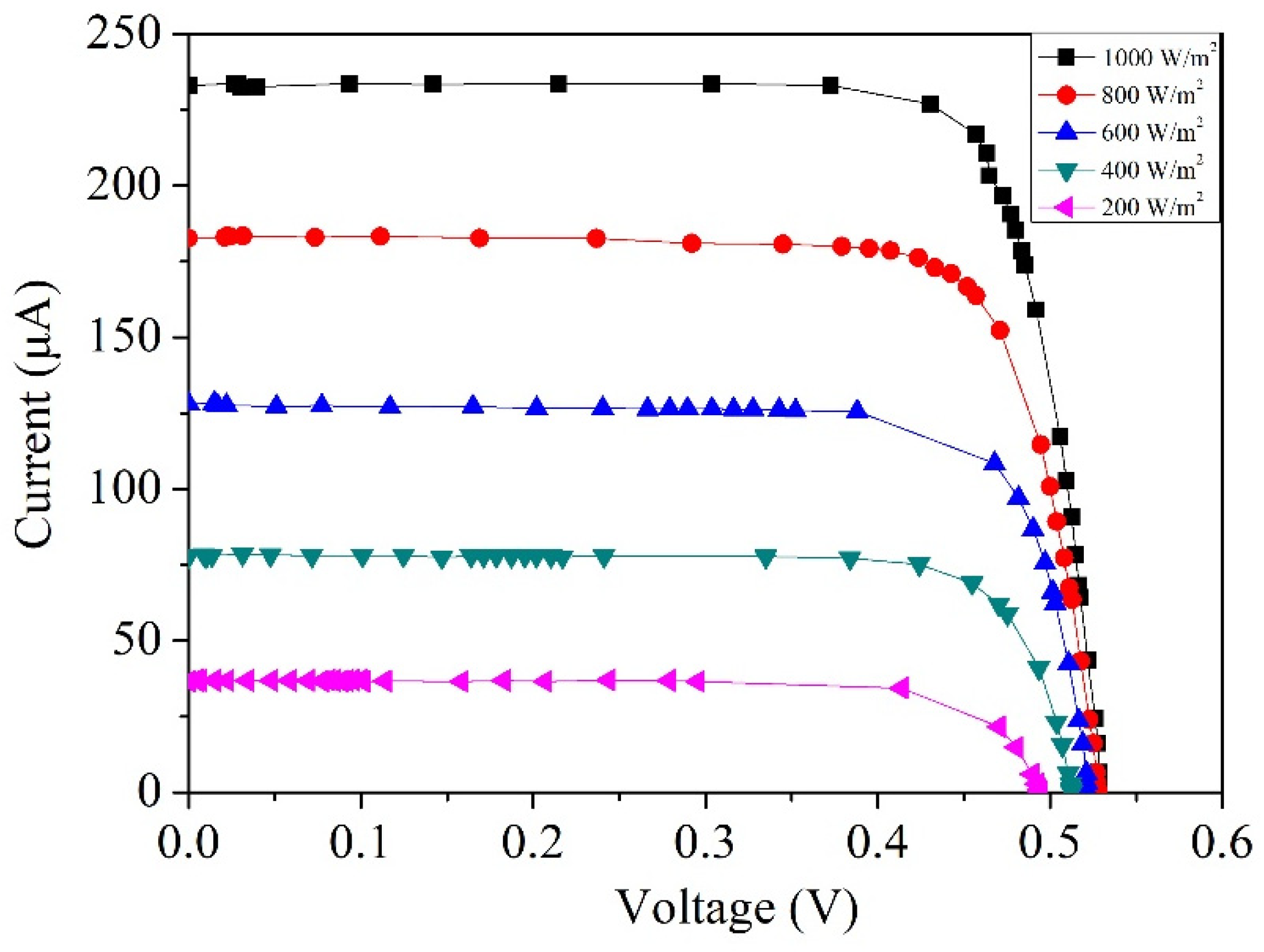

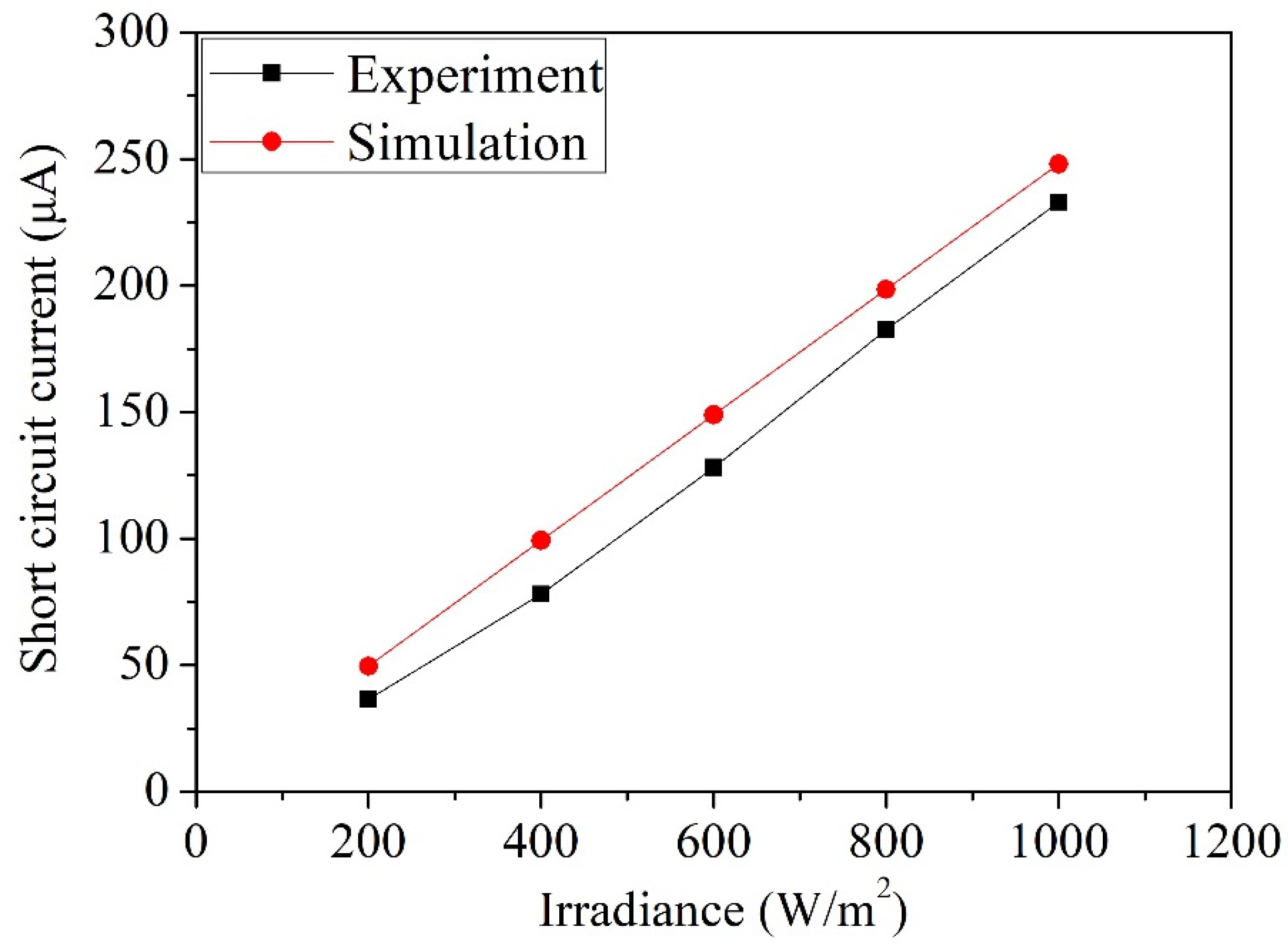
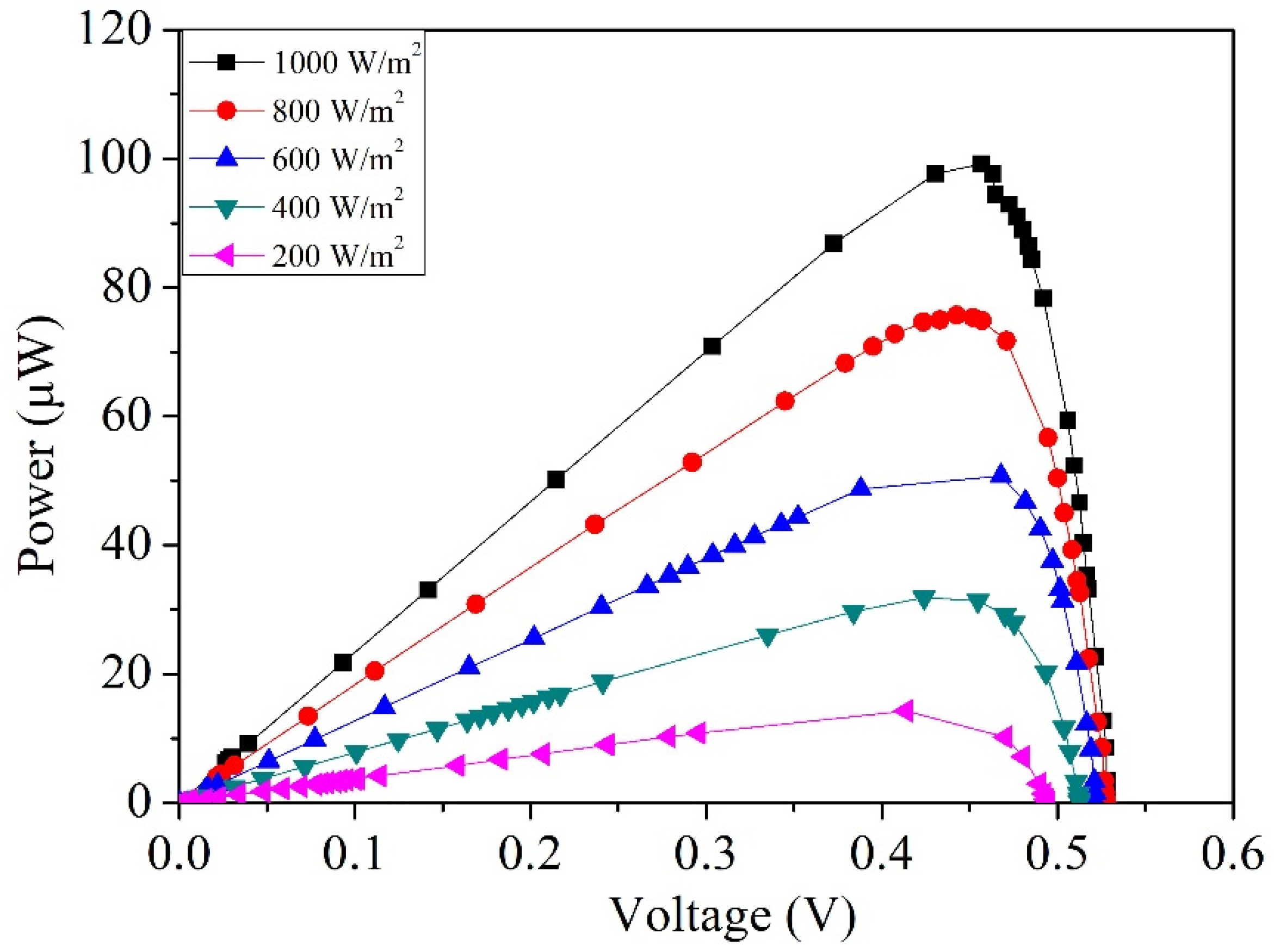
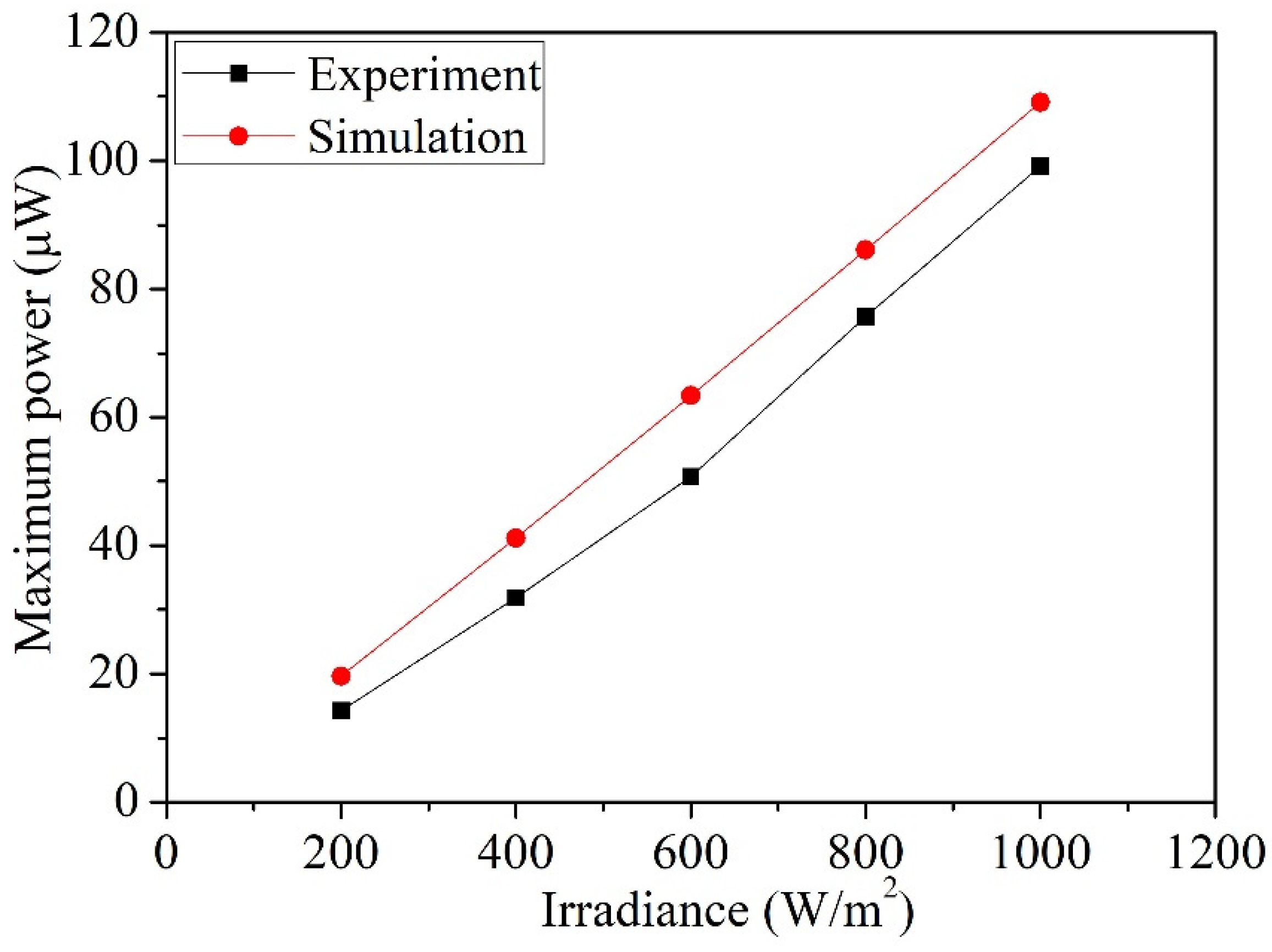
| Authors | Open-Circuit Voltage (V) | Short-Circuit Current | Energy-Conversion Efficiency (%) |
|---|---|---|---|
| Sakai et al. [9] | 0.821 | 5.1 mA | 2.35 |
| Arima et al. [10] | 0.83 | 0.4 μA | 2.6 |
| Law et al. [12] | 0.84 | 1.25 nA | 0.3 |
| Horiguchi et al. [13] | 1.3 | 6 μA | 7.5 |
| Hung et al. [14] | 0.57 | 35 mA | 15 |
| Hung et al. [15] | 2.05 | 2.6 mA | 11 |
| Hung et al. [16] | 0.5 | 11 μA | 0.5 |
| Yan et al. [17] | 0.53 | 10.6 mA | 4.45 |
| Sichao et al. [18] | 0.53 | 15.3 mA | 5.45 |
| This work | 0.53 | 233 μA | 12.5 |
Disclaimer/Publisher’s Note: The statements, opinions and data contained in all publications are solely those of the individual author(s) and contributor(s) and not of MDPI and/or the editor(s). MDPI and/or the editor(s) disclaim responsibility for any injury to people or property resulting from any ideas, methods, instructions or products referred to in the content. |
© 2023 by the authors. Licensee MDPI, Basel, Switzerland. This article is an open access article distributed under the terms and conditions of the Creative Commons Attribution (CC BY) license (https://creativecommons.org/licenses/by/4.0/).
Share and Cite
Chen, C.-Y.; Dai, Z.-X. Fabrication and Characterization of Photovoltaic Microgenerators Using the Complementary Metal Oxide Semiconductor Process. Micromachines 2023, 14, 2038. https://doi.org/10.3390/mi14112038
Chen C-Y, Dai Z-X. Fabrication and Characterization of Photovoltaic Microgenerators Using the Complementary Metal Oxide Semiconductor Process. Micromachines. 2023; 14(11):2038. https://doi.org/10.3390/mi14112038
Chicago/Turabian StyleChen, Chun-Yu, and Zhi-Xuan Dai. 2023. "Fabrication and Characterization of Photovoltaic Microgenerators Using the Complementary Metal Oxide Semiconductor Process" Micromachines 14, no. 11: 2038. https://doi.org/10.3390/mi14112038
APA StyleChen, C.-Y., & Dai, Z.-X. (2023). Fabrication and Characterization of Photovoltaic Microgenerators Using the Complementary Metal Oxide Semiconductor Process. Micromachines, 14(11), 2038. https://doi.org/10.3390/mi14112038






